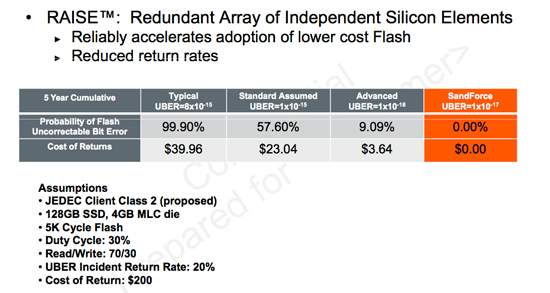Western Digital SiliconEdge Blue Review: WD Enters the Consumer SSD Market
by Anand Lal Shimpi on March 3, 2010 12:00 AM EST- Posted in
- Storage
Scrambling Data to Improve Reliability?
I secure erase all SSDs before I run any test, unless I'm testing used performance. On a modern SSD, performing an ATA Secure Erase takes anywhere from 30 - 50 seconds in most cases. The first time I went to secure erase the SiliconEdge Blue it took almost 17 minutes. I asked Western Digital what was going on, and got an interesting explanation.
The smaller NAND flash gets, the more prone the cells are to developing bit errors. That's why SandForce made such a big deal out of its controllers making 34nm possible thanks to extra error correction and redundancy.


SandForce's controllers attempt to fix bit errors in order to enable the use of cheaper MLC NAND
Western Digital found that writing certain combinations of data were more prone to generating these bit errors on smaller dimension flash (< 50nm). To prevent these sorts of errors from cropping up, the controller reorganizes (or scrambles) the data it's fed before writing it to the flash. When you go back to read the data off the flash, it's unscrambled before sending it back to the host controller so you get the data you requested.
![]()
As a side effect, the controller can't simply perform a flash erase to zero out the contents of the drive. Instead the SiliconEdge Blue has to physically write (a F or 0) to every NAND flash cell on the drive itself, which takes some time. On the bright side, WD does this to improve data integrity (or more likely to use cheaper MLC NAND without sacrificing reliability). The only downside is that a secure erase, which you shouldn't need to do that often, will take a long time to complete.










64 Comments
View All Comments
chuckbam - Saturday, March 20, 2010 - link
I buy Intel for the Intel SSD Toolbox utility. With win7, I load the Intel chipset inf, Matrix Storage Manager and am not sure if Trim still works.I am happy to see WD into this market. Prices need to come WAY DOWN!
Sabresiberian - Saturday, March 13, 2010 - link
As a great fan of the Raptor series drives, what I want from WD is the same concept in SSD: the top performance and super reliability it is. The down side of course in a VelociRaptor is its relative price - and, as expensive as SSDs still are, a comparable price for an SSD "VelociRaptor" would be extreme.Still, it's what I want, and I could certainly see me building a high-end system using smaller capacity WD SSD "Raptors" in Raid 0 for that extreme performance goofy people like me want to have. If I get an extra few grand handed to me, I would use larger drives, of course.
Anyhoo, this drive is not what I want to see from WD (unless of course it really does kick reliability butt over its competitors). Hopefully by the time I build another high-end rig (just built one so it will be awhile, likely) WD will have what I want (or someone), a SSD successor to VelociRaptor mechanical hard drives.
liquoredonlife - Wednesday, March 10, 2010 - link
Great article Anand! Also thanks for reiterating the incompatibility with gen2 unibody macbook pro's and particular SSDs. Will you be able to test this SSD with your mbp?heulenwolf - Wednesday, March 10, 2010 - link
Anand mentioned some possible convergence between magnetic and solid state drive firmware development. Could this mean the mythical hybrid drive is down the road somewhere? With single spindles holding in excess of 300 GB and SSDs not even filling the 2.5" form factor, isn't there room for both? If not both storage types in one drive then maybe both storage types in one drive slot? Then you could have the boot drive be the super fast SSD and the advantage of cheaper, higher-capacity storage of a single-spindle magnetic drive in a single laptop. I think this dual-drive approach could be a better solution than the hybrid drive until caching in drive controllers becomes smarter.GullLars - Sunday, March 7, 2010 - link
These drives clearly don't support NCQ, as IOPS don't scale with QD.The rating of 5000 IOPS is about the same as the rating of a single NAND TSOP. You can literaly get the same random IOPS performance from a thumbnail USB drive.
ky - Thursday, March 4, 2010 - link
Can someone explain why there's a dropoff in performance between the 100GB and 50GB Mercury Extreme SSDs in the 4K Aligned random write test?cactusdog - Thursday, March 4, 2010 - link
Oh well nothing to see here either. I dont see how they can justify the price. A SSD with a PCB and some chips should be cheaper to make than a mechanical hard drive with moving metal parts. Fair enough to pay a little extra for new tech but this is ridiculous.Hrel - Wednesday, March 3, 2010 - link
I'd really like to see performance of two 7200rpm drives in a striped RAID thrown into these charts. So please get on that.7Enigma - Thursday, March 4, 2010 - link
I'll save you the time of waiting.-Sequential Read and Write: Near twice the performance of a single drive
-Random 4K read/write: Just as bad as a single drive
Fin~
GeorgeH - Wednesday, March 3, 2010 - link
Going from WD's HDD naming conventions I would expect average but reliable performance from a "Blue" SSD, and that appears to be exactly what they've delivered, albeit at a ridiculously high price.The WD SSD I'm really interested in is the "SiliconEdge Black", a drive that will hopefully be forthcoming after their sales division puts down the crack pipe and gets serious about SSD pricing.